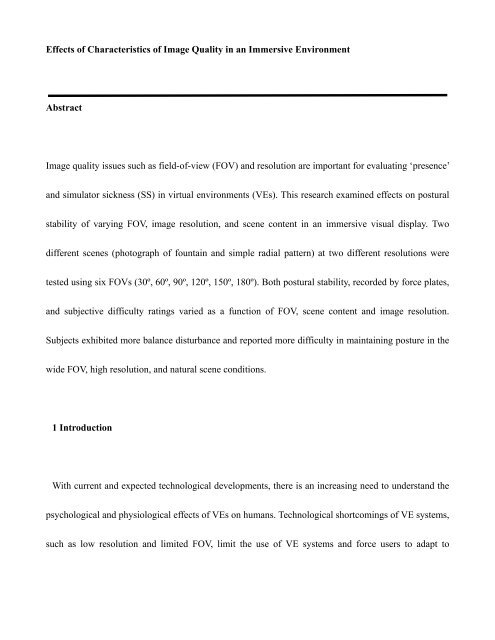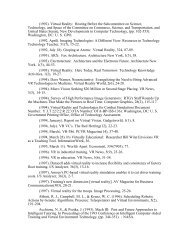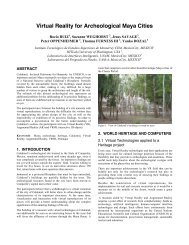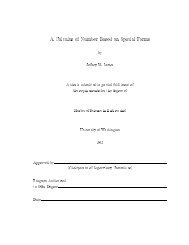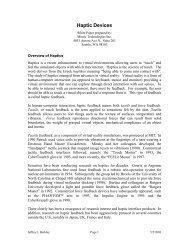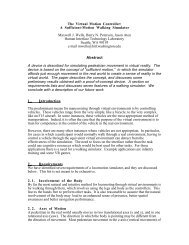Henry B - Human Interface Technology Laboratory - University of ...
Henry B - Human Interface Technology Laboratory - University of ...
Henry B - Human Interface Technology Laboratory - University of ...
Create successful ePaper yourself
Turn your PDF publications into a flip-book with our unique Google optimized e-Paper software.
Effects <strong>of</strong> Characteristics <strong>of</strong> Image Quality in an Immersive Environment<br />
Abstract<br />
Image quality issues such as field-<strong>of</strong>-view (FOV) and resolution are important for evaluating ‘presence’<br />
and simulator sickness (SS) in virtual environments (VEs). This research examined effects on postural<br />
stability <strong>of</strong> varying FOV, image resolution, and scene content in an immersive visual display. Two<br />
different scenes (photograph <strong>of</strong> fountain and simple radial pattern) at two different resolutions were<br />
tested using six FOVs (30º, 60º, 90º, 120º, 150º, 180º). Both postural stability, recorded by force plates,<br />
and subjective difficulty ratings varied as a function <strong>of</strong> FOV, scene content and image resolution.<br />
Subjects exhibited more balance disturbance and reported more difficulty in maintaining posture in the<br />
wide FOV, high resolution, and natural scene conditions.<br />
1 Introduction<br />
With current and expected technological developments, there is an increasing need to understand the<br />
psychological and physiological effects <strong>of</strong> VEs on humans. Technological shortcomings <strong>of</strong> VE systems,<br />
such as low resolution and limited FOV, limit the use <strong>of</strong> VE systems and force users to adapt to
non-optimal conditions (Stanney and Salvendy, 1998). Consider for example SS / VE sickness (or<br />
so-called cybersickness). Most users experience some level <strong>of</strong> SS the first time they use a VE system<br />
(Regan and Price, 1994). With repeated exposures, they adapt and SS symptoms decrease. Hettinger et al.<br />
(1987) suggested that SS may correlate with the ability <strong>of</strong> a VE to elicit illusory self-motion (vection).<br />
Hypothesized contributors to SS also include scene content, FOV, image resolution, motion trajectory,<br />
frequency characteristics <strong>of</strong> scene motion, etc. Postural disturbance has been proposed for evaluating VE<br />
systems (Stanney and Salvendy, 1998). Kennedy and Stanney (1996) evaluated postural stability<br />
measures for assessing aftereffects from VE exposure. Previous studies (Cobb and Nichols, 1998;<br />
Hamilton et al, 1989) indicate that balance disturbance correlates with simulator sickness. Also, balance<br />
disturbance has been suggested as a surrogate measure for SS intensity. Scene content, FOV, image<br />
resolution, motion trajectory, and frequency characteristics <strong>of</strong> scene motion affect vection as well as SS.<br />
Vection, presence and SS are related to postural disturbance. In this study, we examine effects <strong>of</strong> FOV,<br />
image resolution and scene content on postural disturbance.<br />
1.1 Central/Peripheral vision<br />
Vection has been proposed as a contributor to presence in virtual environments (McGreevy, 1992) and<br />
to inducing SS (Kennedy, Hettinger, & Lilienthal, 1990). Because large FOVs stimulate peripheral
egions <strong>of</strong> the retina, they may more effectively produce self-motion perception (Hettinger et al., 1987).<br />
Questions about the region <strong>of</strong> the retina most responsible for the perception <strong>of</strong> self-motion has been<br />
asked by many researchers (see Wolpert, 1990). Initial reports indicated that stimulation <strong>of</strong> peripheral<br />
areas <strong>of</strong> the retina was more effective in eliciting perception <strong>of</strong> self-motion than simulation <strong>of</strong> more<br />
central areas (Dichgans & Brandt, 1978; Held, Dichgans, & Bauer, 1975).<br />
These experiments led scientists to theorize that human vision is mediated by two functionally different<br />
systems. Leibowitz and Post (1982) extended the notion <strong>of</strong> “two modes <strong>of</strong> processing spatially<br />
distributed information” which was proposed by Held (1970) and others. The two-modes model <strong>of</strong><br />
spatial processing described two different kinds <strong>of</strong> visual functions associated with different parts <strong>of</strong> the<br />
brain. These are the focal mode and the ambient mode. The former was thought to be responsible for<br />
object recognition and identification and concerned with the ‘what’ question. The later was thought to be<br />
responsible for spatial orientation, locomotion and posture and concerned with the ‘where’ question.<br />
Several studies examined this theory. Brandt, Dichgans, and Koenig (1973) found that when the central<br />
retina was stimulated, self-motion was not experienced, but strong self-rotation was elicited when the<br />
peripheral retina was exposed to optical flow. Hulk and Rempt (1983) using sine-wave gratings <strong>of</strong>
various widths, found that self-motion was most frequently reported at FOV eccentricities <strong>of</strong> 50º and 60º,<br />
with the slower angular velocities <strong>of</strong> 10º/sec - 15º/sec proving most effective. Howard and Heckmann<br />
(1989) reported that when stimuli were presented in the peripheral visual field, the self-motion<br />
experienced by subjects was stronger than when the stimuli were presented in the central visual field.<br />
However, vection was reduced when the central stimuli moved opposite to the direction <strong>of</strong> the peripheral<br />
stimuli. Howard, Ohmi, Simpson, and Landolt (1987) reported that strong vection could be evoked by a<br />
centrally located moving pattern if that pattern was perceived as being more distant than a stationary<br />
surround. Vection appears to be strongly related to the perceptual distinction between foreground and<br />
background.<br />
Warren and Kurtz (1992) reviewed several experiments that contradicted Brandt’s et al. (1973)<br />
peripheral dominance hypothesis – that peripheral vision is specialized for self-motion perception. Based<br />
on studies <strong>of</strong> perceived heading accuracy, Warren and Kurtz found that the periphery is less sensitive to<br />
radial optical flow than the central region. Even FOVs as small as 10°-25° evoked self-motion<br />
perception. St<strong>of</strong>fregen (1985) reported that postural adjustments were evoked by either radial or parallel<br />
(lamellar) optical flow in the central visual field but only by lamellar flow in the periphery. Anderson and<br />
Braunstein (1985) found that with a display subtending angle as small as 7.5°, subjects still reported<br />
vection and motion sickness. They suggested that representation <strong>of</strong> motion in depth might be the critical
element in perceiving self-motion.<br />
1.2 FOV/SS/Presence/Spatial awareness<br />
Effects on SS and performance <strong>of</strong> image quality variables such as FOV and resolution have been<br />
examined by several investigators. Stanney and Salvendy (1998) proposed that FOV and display<br />
resolution may affect the usability <strong>of</strong> a display system and may correlate with motion sickness. Users<br />
usually report higher incidence <strong>of</strong> SS with a wide FOV display than with a narrow one (Kennedy,<br />
Lilienthal, Berbaum, Berbaum, and McCauley, 1989). A wide FOV display can maximize immersion <strong>of</strong><br />
the user in the virtual environment. DiZio and Lackner (1997) evaluated 21 subjects in two different FOV<br />
conditions. Subjects reported more motion sickness symptoms during 15 min exposures when using a<br />
wide FOV head-mounted-display (HMD) (138º horizontal by 110º vertical) than did subjects who were<br />
exposed to a FOV half as large. Narrow FOVs may degrade the sense <strong>of</strong> presence (Prothero and<br />
H<strong>of</strong>fman, 1995; Hettinger, Nolan, Kennedy, Berbaum, Schnitius and Edinger, 1987). Users’ experience<br />
<strong>of</strong> SS varied with VE systems characteristics. There is no generally accepted conclusion regarding the<br />
relationship between SS and presence. Some studies showed that they are positively correlated; other<br />
studies reported a negative correlation (see Stanney and Salvendy, 1998). Stanney and Salvendy (1998)<br />
suggested that both SS and presence may correlate with intervening variables such as vection.
FOV may also influence spatial awareness in VEs. Witmar, Bailely, and Knerr (1994) reported that<br />
when subjects moved through a VE, limited FOV could cause frequent collisions with walls and<br />
doorways. Subjects apparently failed to detect VE features such as intersections between the walls and<br />
floor, etc. Kline and Witmer (1996) found that distance estimates were also affected by FOV. They tested<br />
12 different viewing distances in a VE (1-12 feet). Subjects overestimated distances when presented with<br />
a narrow FOV (60º X 38.5º) and underestimated the same distances with a wide FOV (140º X 90º).<br />
Limited FOV interfered with development <strong>of</strong> spatial knowledge and increased navigational difficulties<br />
(Alfano and Michel, 1990). McCreary and Williges (1998) reported that when using an HMD, larger<br />
FOVs resulted in greater route and configuration knowledge while landmark knowledge was not<br />
significantly changed. Kenyon and Kneller (1993) examined a visual nulling task at five different FOVs<br />
(10º, 20º, 40º, 80º and 120º). They found that subjects’ minimum RMS error occurred at 80º, not 120º.<br />
Also subjects reported greater task difficulty at the 120º FOV than at 80º. They suggested that subjects<br />
experienced stronger vection at the 120º FOV, making the nulling task more difficult.<br />
1.3 Image Resolution<br />
Pausch, Crea and Conway (1992) suggested that display FOV is only one <strong>of</strong> several factors that may
contribute to SS. Higher picture resolution and quality may allow more information to be present in<br />
particular display areas. Higher resolution permits increased scene information and ‘realism.’ Welch et<br />
al. (1996) found that pictorial realism correlated with perceived sense <strong>of</strong> presence. However, it is difficult<br />
to evaluate effects <strong>of</strong> resolution and realism because <strong>of</strong> possible interactions with other display<br />
characteristics such as FOV.<br />
Ziefle (1998) investigated effects <strong>of</strong> 3 different resolutions, using a cathode-ray-tube (CRT) display, on<br />
eye movements during a visual search task. Reaction times and fixation durations were increased in the<br />
low-resolution condition (62 dpi [dots per inch], 720 X 540 pixels) as compared with the high-resolution<br />
condition (89 dpi, 1024 X 768 pixels) by 19% and 9.6% respectively. Gould et al. (1987) found that the<br />
higher the resolution <strong>of</strong> the display, the better the reading performance. Kline and Witmer (1996) studied<br />
effects <strong>of</strong> 3 texture resolutions (512 X 512 pixels, 16 X 16 pixels and no texture) and 2 texture types (rich,<br />
emergent and poor, non-emergent) on distance estimates. They found that fine texture resolution<br />
improved the accuracy <strong>of</strong> estimates for distances under 6 feet when using a narrow FOV. They suggested<br />
that higher texture resolution might improve depth perception and distance estimation in a narrow FOV<br />
VE system. However, Watson et al. (1997) found that degrading visual resolution in the periphery did not<br />
significantly reduce visual search performance.
1.4 Problem<br />
Previous studies suggest the FOV and resolution affect task performance in VEs. Also, the experience <strong>of</strong><br />
self-motion depends in part on motion cues in the peripheral region <strong>of</strong> the retina. Wide FOV displays can<br />
elicit greater immersion in the VE and may enhance the experience <strong>of</strong> presence. Bullinger, Bauer &<br />
Braun (1997) recommended using a 120º horizontal by 60º vertical FOV and 9000 by 3600 pixel<br />
resolution for VE systems. On the other hand, stronger vection, which is one <strong>of</strong> the factors that may<br />
contribute to SS, is also more likely with such display. Both FOV and resolution are critical issues for VE<br />
research. Moreover, interactions between FOV and resolution need to be evaluated.<br />
As noted above, previous research indicates that postural stability is related to self-motion perception,<br />
presence and SS. This study used postural stability measures to investigate effects <strong>of</strong> different FOVs,<br />
scene resolutions and scene contents.<br />
2. Experiment<br />
2.1 Subjects.<br />
10 subjects (7 women and 3 men), ages 20 to 30, were recruited from the <strong>Human</strong> <strong>Interface</strong> <strong>Technology</strong>
<strong>Laboratory</strong> subject pool. None reported a history <strong>of</strong> auditory disturbance, balance disorders, back<br />
problems, or high susceptibility to motion sickness. All subjects reported that they had normal or<br />
corrected vision. Subjects were paid $10/ hour. The protocol was approved by the <strong>University</strong> <strong>of</strong><br />
Washington <strong>Human</strong> Subjects Review Committee.<br />
2.2 Apparatus.<br />
The experimental setting is shown in Figure 1. Visual scene motion was generated by computer<br />
s<strong>of</strong>tware. The scene update rate was about 60 frames / sec. Two computer-generated scenes (fountain<br />
scene – <strong>University</strong> <strong>of</strong> Washington Fountain scene and simple scene - radial pattern) with two resolutions<br />
- 600 by 600 dpi and 256 by 256 dpi were used (see Figure 2). The back-projected images from a Kodak<br />
DP1100 projector (1024 X 768 pixel resolution - Kodak, Inc.) were presented on a 3-foot dome which<br />
has a nominal 180º x 180º FOV. Subjects stood on a Chattecx balance platform (Chattecx Corp.) that<br />
automatically calculated dispersion around the center-<strong>of</strong>-balance based on signals (100 Hz sampling rate)<br />
generated by force plates under their feet.<br />
2.3 Procedure<br />
Frontal visual scene roll oscillation was presented at a low frequency - 0.05 Hz (see Parker et al. 2001).
Peak scene angular velocity was constant at approximately 70º / sec. Three different scenes (600 dpi<br />
fountain scene, 600 dpi simple scene and 256 dpi fountain scene) were presented at six different FOVs<br />
(+/-15º, 30º, 45º, 60º, 75º, 90º from the center <strong>of</strong> the visual field). Data were collected with the subjects in<br />
a sharpened Rhomberg stance (Hamilton, Kantor, and Magee, 1989). They stood on the balance platform<br />
one foot in front the other and with their arms crossed behind their backs, as described by Parker et al.<br />
(2001). 4 trials (replicates) were collected in each stimulus condition. 10 sec periods <strong>of</strong> baseline data<br />
while viewing a static scene were collected before and after the visual stimulus trials. For the<br />
experimental conditions, the subjects looked at the moving scene for 10 sec while holding the support<br />
bars, assumed the Rhomberg position, and attempted to stand steady during the 10 sec data collection.<br />
The subject’s eyes were closed except during the visual stimulus trials. The order <strong>of</strong> FOV conditions was<br />
partially counterbalanced across all subjects. To avoid fatigue and learning effects, the experimental<br />
conditions were presented in two sessions with a 3 day interval between sessions. The following data<br />
were collected for each trial: subjects’ rating <strong>of</strong> difficulty (difficulty in maintaining the Rhomberg stance,<br />
1-10 scale, 1 is easiest, 10 is hardest), dispersion <strong>of</strong> center-<strong>of</strong>-balance. (Dispersion is a measure <strong>of</strong><br />
variability with respect to the center-<strong>of</strong>-balance in the two-dimensional -- fore-aft and side-to-side --<br />
plane <strong>of</strong> the balance platform.)
3. Results<br />
Because <strong>of</strong> large inter- and intra-subject variability, subjective difficulty ratings and balance dispersion<br />
scores were ‘standardized’: each visual trial score was divided by the average baseline performance for<br />
that subject. Results from this study are summarized in Figure 3. Means for the dependent variables were<br />
calculated using repeated-measures ANOVAs. For the dispersion data, there was a statistically<br />
significant main effect <strong>of</strong> scene [F(2,18)=61.978, p < 0.01]; the main effect <strong>of</strong> FOV was also significant<br />
[F(5,45)=50.621, p
fountain scenes across the FOV conditions. For the dispersion data, the main effect <strong>of</strong> resolution was<br />
significant [F(1,9)=60.010, p
4. Discussion<br />
All the data showed the same trend – with increasing FOV, subjects exhibited more dispersion and<br />
reported more difficulty keeping their balance. For the standardized dispersion data, failure to observe<br />
“saturation” at the extreme FOVs was surprising. Subjects’ standardized dispersion continued to increase<br />
up to the largest FOV across all three visual conditions. With increasing FOV, subjects received more<br />
information from their peripheral visual field; and, this peripheral stimulation apparently caused greater<br />
postural disturbance. These findings support previous assertions that wide FOVs cause greater<br />
self-motion perception and postural disturbance. The results also suggest that people in wide FOV,<br />
high-resolution displays might report more SS and presence.<br />
In contrast to the dispersion results, there is a “plateau” in the difficulty rating data. The plateau<br />
occurred between 120° and 150° FOVs across the three visual conditions. Possible explanations for this<br />
include the following. First, the subjects’ perceptual scale for difficulty rating may have “saturated.”<br />
During post-experiment debriefings, several subjects reported that they could not tell the difference<br />
between 150° and 180° FOV conditions, that it was hard for them to maintain balance in both conditions.<br />
Second, the rating data may reveal a “ceiling effect.” Subjects frequently fell in both the 150° and 180°<br />
FOV conditions. The highest rating scale value - “10” – was automatically assigned when subjects broke
stance or fell.<br />
Interestingly, small FOVs can evoke substantial postural disturbance. Our results showed that even the<br />
30° FOV evoked postural disturbance 1.5 times as large as the baseline condition for standardized<br />
dispersion and 2 times more than baseline for standardized rating. The data are consistent with Howard<br />
and Heckmann’s (1989) results for vection but in opposition to the Brandt et al. (1973) peripheral<br />
dominance hypothesis. Our results are consistent with the functional sensitivity hypothesis proposed by<br />
Warren and Kurtz (1992). In contrast to Brandt’s peripheral dominance hypothesis, they proposed that<br />
central and peripheral vision are sensitive to different information. Apparently, self-motion perception is<br />
evoked by different classes <strong>of</strong> optical information. Central retinal cells extract radial, rotary and lamellar<br />
flow information, whereas peripheral cells respond to lamellar flow pattern (Storffregen, 1985).<br />
Duh, Parker and Furness (2001) used an “independent visual background” (IVB) in the peripheral or<br />
central visual field to reduce scene-motion-induced balance disturbance. They were surprised to find that<br />
an IVB located in the visual periphery was less effective than one located in the central visual field. This<br />
finding may be explained by Storffregen’s results and functional sensitivity hypothesis. It is possible<br />
central and peripheral cells differ in their ability to parse moving scene and static information. Further<br />
experiments to explore the differences in central and peripheral processing are needed.
Scene content and resolution also appear to be important variables. Subjects exhibited greater postural<br />
disturbance and reported more difficulty in maintaining upright posture with the fountain scene than the<br />
simple scene when both were presented at high resolution. The fountain scene provides more 2-D<br />
(monocular) depth cues, more up-down polarity cues, and more meaningful information than the simple<br />
scene. Also, there was a significant interaction between FOV and scene content. Subjects exhibited small<br />
differences in dispersion with narrow FOVs but large differences with wide FOVs. Larger FOVs may<br />
provide more depth cues.<br />
Subjects also exhibited greater postural disturbance and reported more difficulty in maintaining upright<br />
posture with the high-resolution fountain scene than the low-resolution fountain scene. Dispersion<br />
differences between high- and low-resolution scenes in the wide FOV condition were larger than in<br />
narrow FOV condition. Apparently, the higher spatial frequencies in the high-resolution scene conveyed<br />
a greater sense <strong>of</strong> realism than the low-resolution fountain scene.<br />
This study demonstrated relationships between postural disturbance and both FOV and scene<br />
resolution. As noted above, previous studies indicate that postural disturbance correlates with presence<br />
and SS. Therefore, our results in conjunction with previous research suggest that FOV and scene
esolution are related to presence and SS.<br />
In summary, the results from this experiment indicated that postural stability varied as a function <strong>of</strong><br />
display FOV, resolution and scene content. Subjects exhibited more balance disturbance with increasing<br />
FOVs, higher resolutions and more complex scene contents. This implies that when we present scenes<br />
with different contents, different levels <strong>of</strong> interactivity, and different resolutions in immersive<br />
environments, different FOVs may be required to minimize postural disturbance. Further, our results<br />
suggest that to achieve a minimum level <strong>of</strong> presence, the characteristics <strong>of</strong> image quality should be<br />
carefully addressed. Future research will focus on relationships among independent variables including<br />
FOV, image resolution, scene content and interactive control using presence and performance as<br />
dependent variables.<br />
Acknowledgments<br />
Supported by NASA Grants NAG5-4074 and an Eastman Kodak Contract. We thank D. L. Harm for<br />
loaning us the balance platform used in this study and H. Abi-Rached for s<strong>of</strong>tware development.
References<br />
1. Alfano, P., & Michel, G. (1990). Restricting the field-<strong>of</strong>-view: perceptual and performance effects.<br />
Perceptual and Motor Skills, 70, 35-45<br />
2. Anderson, G.L., & Braunstein, M.L. (1985). Induced self-motion in central vision. Journal <strong>of</strong><br />
Experimental Psychology: <strong>Human</strong> Perception and Performance, 11, 122-132<br />
3. Brandt, T., Dichgans, J., & Koenig, E. (1973). Differential effects <strong>of</strong> central versus peripheral vision on<br />
egocentric and exocentric motion perception. Experimental Brain Research, 16, 476-491<br />
4. Bullinger, H.J., Bauer, W. Braun, M. (1997). Virtual environments. In G. Salvendy(eds.). Handbook <strong>of</strong><br />
<strong>Human</strong> Factors and Ergonomics, NY: Springer-Verlag<br />
5. Cobb, S.V.G.., & Nichols, S.C. (1998). Static posture tests for the assessment <strong>of</strong> postural instability<br />
after virtual environment use. Brain Research Bulletin, 47(5), 459-464<br />
6. Dichgans, J., and Brandt, T. (1978). Visual-vestibular interaction: Effects on self-motion perception<br />
and postural control. In R., Held, & H.W., Leibowitz, (Eds.), Handbook <strong>of</strong> sensory physiology (Vol.<br />
VIII). New York: Springer-Verlag, 756-795<br />
7. DiZio, P. and Lackner, J.R., (1997). Circumventing side effects <strong>of</strong> immersive virtual environments. In<br />
M., Smith, & R., Salvendy, (Eds), Design <strong>of</strong> computing system: Social and ergonomic considerations<br />
(pp. 893-896). Amsterdam: Elsevier.
8. Duh, H.B.L., Parker, D.E. and Furness, T.A. (2001). An “Independent visual background” reduced<br />
balance disturbance evoked by visual scene motion: implication for alleviating simulator sickness. In<br />
Proceedings <strong>of</strong> ACM CHI 2001, Seattle, WA, March/31 –April/5, 85-89.<br />
9. Gould, J.D., Alfaro, L., Finn, R., Haupt, B., and Minuto, A. (1987). Reading from CRT displays can be<br />
as fast as reading from paper. <strong>Human</strong> Factors, 29, 269-299<br />
10. Hamilton, K.M., L. Kantor, & Magee, L.E. (1989). Limitations <strong>of</strong> postural equilibrium tests for<br />
examining simulator sickness. Aviation, Space, and Environment Medicine, 59, 246-251<br />
11. Held, R. (1970). Two modes <strong>of</strong> processing spatially distributed visual stimulation. In F.O., Schmitt<br />
(Eds.), The neurosciences: second study program. NY: Rockefeller <strong>University</strong> Press<br />
12. Held, R., Dichgans, J., & Bauer, J. (1975). Characteristics <strong>of</strong> moving visual scenes influencing spatial<br />
orientation, Vision Research, 15, 357-365<br />
13. Hettinger, L.J., Nolan, M.D., Kennedy, R.S., Berbaum, K.S., Schnitzius, K.P. & Edinger, K.M.,<br />
(1987). Visual display factors contributing to simulator sickness. Proceedings <strong>of</strong> the <strong>Human</strong> Factors<br />
Society 31st Annual meeting, Santa Monica, CA: <strong>Human</strong> Factors Society, 497-501<br />
14. Howard, I.P. and Heckmann, T. (1989). Circular vection as a function <strong>of</strong> the relative sizes, distances<br />
and positions <strong>of</strong> two competing visual displays. Perception, 18, 657-667<br />
15. Howard, I.P., Ohmi, M., Simpson, W. and Landolt, J. (1987). Vection and the spatial disposition <strong>of</strong><br />
competing moving displays. Proceedings <strong>of</strong> the AGARD Conference on Motion Cues in Flight
Simulation and Simulator sickness. Brussels.<br />
16. Hulk, J., & Rempt, F. (1983). Vertical optokinetic sensations by limited stimulation <strong>of</strong> the peripheral<br />
field <strong>of</strong> vision. Ophthalmologica, 186, 97-103<br />
17. Kennedy, R.S., & Stanney, K.M. (1996). Postural instability induce by virtual reality exposure:<br />
Development <strong>of</strong> certification protocol. International Journal <strong>of</strong> <strong>Human</strong>-computer Interaction, 8(1),<br />
25-47<br />
18. Kennedy, R.S., Hettinger, L.J., &. Lilienthal, M.G. (1990). Simulator sickness. In G.H., Crampton,<br />
(Eds.), Motion and space sickness (pp317-341). Boca Ration, FL: CRC Press.<br />
19. Kennedy, R.S., Lilienthal, M.G., Berbaum, K.S., Berbaum, D.R., & McCauley, M.E. (1989).<br />
Simulator sickness in U.S. Navy flight simulators. Aviation, space and Environmental Medicine, 60(1),<br />
10-16<br />
20. Kenyon, R.V., & Kneller, E.W. (1993). The effects <strong>of</strong> filed <strong>of</strong> view size on the control <strong>of</strong> roll motion.<br />
IEEE Transactions on Systems, Man, and Cybernetics. 23(1), 183-193<br />
21. Kline, P.B., & Witmer, B.G. (1996). Distance perception in virtual environments: effects <strong>of</strong> field <strong>of</strong><br />
view and surface texture at near distances. Proceedings <strong>of</strong> the <strong>Human</strong> Factors and Ergonomics Society<br />
40th Annual Meeting, 1112-1116<br />
22. Leibowitz, H.W., & Post, R. B. (1982). The two modes <strong>of</strong> processing concept and some implications<br />
In Beck, J.(Eds.), Organization and representation in perception. Mahwah, NY: Erlbaum
23. McCreary, F.A., & Williges, R.C. (1998). Effects <strong>of</strong> age and field-<strong>of</strong>-view on spatial learning in an<br />
immersive virtual environment. Proceedings <strong>of</strong> the <strong>Human</strong> Factors and Ergonomics Society 42nd<br />
Annual Meeting, 1491-1495<br />
24. McGreevy, M.W. (1992). The presence <strong>of</strong> geologists in Mars-like terrain. Presence: Teleoperator and<br />
Virtual Environments, 1(4), 375-403<br />
25. Parker, D.E., Duh, H.B.L., Philips, J. & Furness, T.A., (2001). Self-motion system frequency<br />
response: implications for cybersickness. Proceedings <strong>of</strong> Second Biennial Space Biomedical<br />
Investigators, Galveston, TX, Jan 17-19, 2001, 242-243<br />
26. Pausch, R., Crea, T., & Conway, M. (1992). A literature survey for virtual environments: military<br />
flight simulator visual systems and simulator sickness. Presence: Teleoperators and Virtual<br />
Environments, 1(3), 344-363<br />
27. Prothero, J.D., and H<strong>of</strong>fman, H.D., (1995). Widening the field-<strong>of</strong>-view increase the sense <strong>of</strong> presence<br />
within immersive virtual environments (<strong>Human</strong> <strong>Interface</strong> <strong>Technology</strong> <strong>Laboratory</strong> Tech. Rep. R-95-4).<br />
Seattle: <strong>University</strong> <strong>of</strong> Washington<br />
28. Regan, E.C., and Price, K.R., (1994). The frequency <strong>of</strong> occurrence and severity <strong>of</strong> side-effects <strong>of</strong><br />
immersion virtual reality. Aviation, Space and Environmental Medicine, 527-530<br />
29. Stanney K. and Salvendy G. (1998). Aftereffects and sense <strong>of</strong> presence in virtual environments:<br />
formulation <strong>of</strong> a research and development agenda. International Journal <strong>of</strong> <strong>Human</strong>-Computer
Interaction, 10(2), 135-187<br />
30. St<strong>of</strong>fregen, T.A. (1985). Flow structure versus retinal location in the optical control <strong>of</strong> stance. Journal<br />
<strong>of</strong> Experimental Psychology: <strong>Human</strong> Perception & Performance, 11, 554-565<br />
31. Warren, H.W., & Kurtz, K.J. (1992). The role <strong>of</strong> central and peripheral vision in perceiving the<br />
direction <strong>of</strong> self-motion. Perception and Psychophysics. 51(5), 443-454<br />
32. Waston, B., Walker, N., Hodges, L.F., & Worden. (1997). Managing level <strong>of</strong> detail through peripheral<br />
degradation: Effects on search performance with a head-mounted display. ACM Transactions on<br />
Computer-<strong>Human</strong> Interaction, 4(4), 323-346<br />
33. Welch, R.B., Blackmon, T.T., Liu, A., Mellers, B.A., & Stark, L.W. (1996). The effects <strong>of</strong> pictorial<br />
realism, delay <strong>of</strong> visual feedback, and observer interactivity on the subjective sense <strong>of</strong> presence.<br />
Presence: Teleoperators and Virtual Environments, 5(3), 263-273<br />
34. Witmer, B.G., Bailey, J.H. and Knerr, B.W. (1994). Training dismounted soldiers in virtual<br />
environments: Route learning and transfer. (ARI Technical Report 1022). Alexandria, VA: U.S. Army<br />
Research Institute for the Behavioral and Social Sciences.<br />
35. Wolpert, L. (1990) Filed-<strong>of</strong>-view information for self-motion perception, In R., Warren, & A. H.,<br />
Wertheim, (Eds), Perception & control <strong>of</strong> self-motion, NJ: LEA<br />
36. Ziefle, M., (1998). Effects <strong>of</strong> display resolution on visual performance. <strong>Human</strong> Factors, 40(4),<br />
554-568
Ss<br />
3 Foot Dome<br />
Project or<br />
Balance Plateform<br />
Figure 1: Equipment layout
Figure 2: Stimuli. High-resolution (600 x 600 dpi) fountain scene, and simple radial pattern scene (600<br />
x 600 dpi).
Standardized Dispersion<br />
Standardized Rating<br />
7<br />
12<br />
6<br />
10<br />
Mean +- 2 SE Standardized Dispersion<br />
5<br />
4<br />
3<br />
2<br />
1<br />
0<br />
30<br />
60<br />
90<br />
120<br />
150<br />
180<br />
Scene<br />
Fountain_Low Res<br />
Fountain_High Res<br />
Simple<br />
Mean +- 2 SE Standardized Rating<br />
8<br />
6<br />
4<br />
2<br />
0<br />
30<br />
60<br />
90<br />
120<br />
150<br />
180<br />
Scene<br />
Fountain_Low Res<br />
Fountain_High Res<br />
Simple<br />
Field <strong>of</strong> View (degree)<br />
Field <strong>of</strong> View (degree)<br />
Figure 3. Means and standard errors standardized ratings and dispersions as a function <strong>of</strong> field-<strong>of</strong>-view<br />
for simple and fountain scenes. (Note: to preserve readability, the error bars and mean data points for the<br />
FOV conditions are staggered.)


